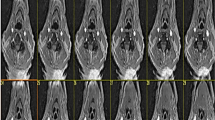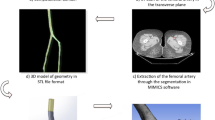Abstract
Objective
The aim of this work is to establish a computational pipeline for the simulation of blood flow in vasculatures and apply this pipeline to endovascular interventional scenarios, e.g. angioplasty in vertebral arteries.
Methods
A patient-specific supra-aortal vasculature is digitized from a 3D CT angiography image. By coupling a reduced formulation of the governing Navier–Stokes equations with a wall constitutive equation we are able to solve the transient flow in elastic vessels. By further incorporating a bifurcation model the blood flow across vascular branches can be evaluated, thus flow in a large vasculature can be modeled. Vascular diseases are simulated by modifying the arterial tree configurations, e.g. the effective diameters, schematic connectivity, etc. Occlusion in an artery is simulated by removing that artery from the arterial tree.
Results
It takes about 2 min per cardiac cycle to compute blood flow in an arterial tree consisting of 38 vessels and 18 bifurcations on a laptop PC. The simulation results show that blood supply in the posterior region is compensated from the contralateral vertebral artery and the anterior cerebral arteries if one of the vertebral arteries is occluded.
Conclusion
The computational pipeline is computationally efficient and can capture main flow patterns at any point in the arterial tree. With further improvement it can serve as a powerful tool for the haemodynamic analysis in patient-specific vascular structures.
Similar content being viewed by others
References
Slovut DP, Bacharach JM (2007) Endovascular therapy for brachiocephalic vessels. In: Rooke TW (eds) chap 27: Vascular medicine and endovascular interventions. Blackwell Futura, Oxford, pp 267–276
Rzucidlo EM, Naylor AR (2006) Arch vessel, vertebrovascular, and upper extremity. In: Davies AH, Brophy CM (eds) chap 16, Vascular surgery. Springer, London, pp 181–190
Stroud JS, Berger AS, Saloner D (2002) Numerical analysis of flow through a severely stenotic carotid artery bifurcation. J Biomech Eng 124: 9–20
Perktold K, Resch M, Peter R (1991) Three-dimensional numerical analysis of pulsatile flow and wall shear stress in the carotid artery bifurcation. J Biomech 24: 409–420
Long Q, Luppi L, Konig CS, Rinaldo V, Das SK (2008) Study of the collateral capacity of the circle of Willis of patients with severe carotid artery stenosis by 3D computational modeling. J Biomech 41: 2735–2742
Moore SM, Moorhead KT, Chase JG, David T (2005) One-dimensional and three-dimensional models of cerebrovascular flow. J Biomech Eng 127: 440–449
Smith NP, Pullan AJ, Hunter PJ (2000) An anatomically based model of transit coronary blood flow in the heart. SIAM J App Math 62: 990–1018
Huo Y, Kassb G (2007) A hybrid one-dimensional/Womersley model of pulsatile blood flow in the entire coronary arterial tree. Am J Physiol Heart Circ Physiol 292: 2623–2633
Alastruey J, Parker K, Peiro J, Byrd S, Sherwin S (2007) Modelling the circle of Willis to assess the effects of anatomical variations and occlusions on cerebral flows. J Biomech 40: 1794–1805
Thusitha DSM, Cheng LK, Pullan AJ (2007) A model of blood flow in the mesenteric arterial system. Biomed Eng Online 6: 17
Zamir M (2005) The physics of coronary blood flow, chap 2. Springer, New York, pp 35–77
Chandran KB, Yoganathan AP, Rittgers SE (2006) Biofluid mechanics: the human circulation. CRC Press, Boca Raton
Westerhof N, Bosman F, De Vries CJ, Noordergraff A (1969) Analog studies of the human systemic arterial tree. J Biomech 2: 121–143
Quick CM, Leonard EF, Young WL (2002) Adaptation of cerebral circulation to brain arteriovenous malformations increases feeding artery pressure and decreases regional hypotension. Neurosurgery 50: 167–175
Formaggia L, Gerbeau JF, Nobile F, Quarteroni A (2001) On the coupling of 3D and 1D Navier–Stokes equations for flow problems in compliant vessels. Comp Meth App Mech Eng 191: 561–582
Quarteroni A, Tuveri M, Veneziani A (2000) Computational vascular fluid dynamics: problems, models and methods. Comput Visual Sci 2: 163–197
CMGUI website: http://www.cmiss.org/cmgui
Hunter PJ (1972) Numerical solution of arterial blood flow. Master thesis. University of Auckland
Anderson JD (1995) Computational fluid dynamics: the basics with applications, chap 6. McGraw-Hill, New York, pp 216–278
Fung YC (1996) Biomechanics: circulation, chap 3. Springer, New York
Buckenham TM, Wright IA (2004) Ultrasound of the extracranial vertebral artery. Br J Rad 77: 15–20
Prestigiacomo CJ (2006) Surgical endovascular neuroradiology in the 21st century: what lies ahead?. Neurosurgery 59: 48–55
Author information
Authors and Affiliations
Corresponding author
Rights and permissions
About this article
Cite this article
Ho, H., Mithraratne, K., Schmid, H. et al. Computer simulation of vertebral artery occlusion in endovascular procedures. Int J CARS 5, 29–37 (2010). https://doi.org/10.1007/s11548-009-0379-x
Received:
Accepted:
Published:
Issue Date:
DOI: https://doi.org/10.1007/s11548-009-0379-x




